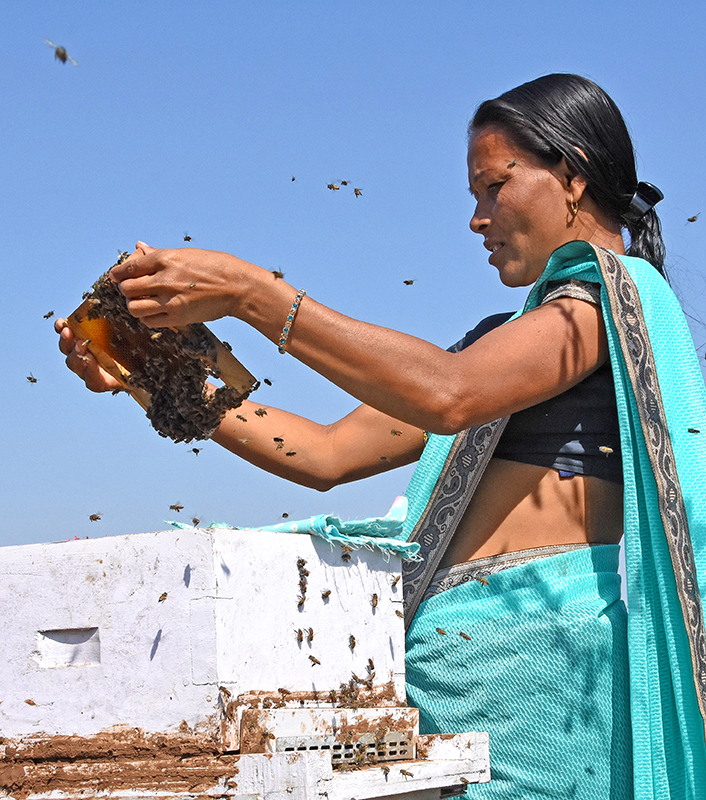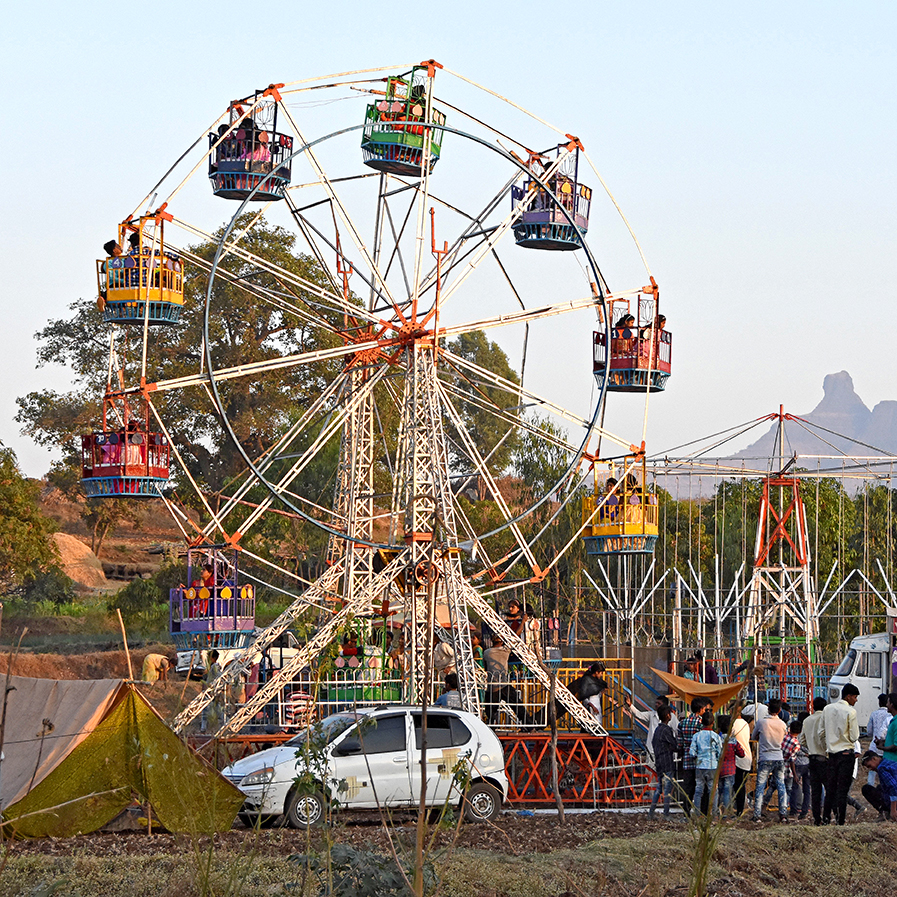In February 2018, Martin and Marianne were invited to Pimpalner by Sujana Kirshnamoorthy to visit an Under the Mango Tree (UTMT) bee project in India. In January, staff of this NGO had undertaken training sponsored by Bees Abroad. Under the Mango Tree works exclusively with Indian honey bees.
Take a map of Maharashtra, find Mumbai, move some 230 km to the east, as the crow flies, zoom way in – and there is Pimpalner, a small rural town with some 12,000 inhabitants.
We arrive on Friday, which is market day. Hundreds of vendors have set up shop in three narrow lanes. Some commercial traders sell dried fish, pulses and spices but they are few and far between the beautiful display of local vegetables.
Mansi and Nikhil from the Under the Mango Tree (UTMT) bee project spot many familiar faces. ‘Usually there are 20 to 30 beekeepers among the vendors,’ says Mansi. ‘More come to shop.’ Like Pandit Chavre and his wife Shushila who have bought okra, fenugreek leaf, potatoes and some dry goods. On their five-acre farm they grow chickpeas, wheat, and onions which are one of the most important cash crops in the area. Onions are used in pretty much every Indian dish and onion prices are an important economic indicator. Onions are pollinated by bees and as farmers save seeds for the next planting season it’s not hard to get them interested in beekeeping.
Over a glass of very sweet tea at the local teashop across the road, Pandit tells us he is the newly elected village headman of Holychapada. Last year Nikhil, Mansi and other UTMT staff held several meetings about beekeeping in the village. Fifteen farmers signed up for the training, including Pandit. Since then he’s helped to find and collect 20 Apis cerana colonies from the wild, and he has high hopes for yield increases for his chilies and onions in particular.
Going Door to Door
Under the Mango Tree started work in the area in 2013. There are now eight villages with experienced beekeepers, and farmers in seven others are still receiving training. Nikhil and Mansi estimate there are about 70 active and over 200 ‘inactive’ beekeepers, ie, those still waiting for a swarm or whose bees have absconded.
Eighteen farmers are now master beekeepers, able to help others with day-to-day tasks, getting colonies from the wild or catching swarms. Trainees (80% of whom are women) receive two bee boxes for free; for every additional box they have to pay Rs 100 (£1). That’s just 10% of the actual cost, but given that a daily wage is Rs 200–300, buying a new box is an investment and a commitment.
A Surprise Swarm
Early the next day we are off to Mauchi Pada village, a 30-minute drive from Pimpalner. In the soft morning light the tree-lined road, the well-tended often lush green fields and the occasional bullock cart make the journey feel like the opening sequence of a film.
Mauchi Pada was one of the first villages where UTMT offered beekeeping training. About 250 families live here and 50 of them now keep bees. ‘Before, we knew nothing about bees,’ says Suman Barish, one of the village’s four master beekeepers. ‘We didn’t know they pollinate our crops. We only went honey hunting and got to the honey by destroying the colonies. No one does that any more.’
Getting started with beekeeping wasn’t easy for Suman; she was badly stung while climbing a tree to collect her first colony but ‘I told the bees that I didn’t want to harm them, so please leave me be’. Not giving up made her a good beekeeper, she says, smiling and holding on to her notebook in which she keeps the records for her 11 bee boxes.
As we talk there is sudden activity around one of the hives. Minutes later Omna, one of Suman’s beekeeper colleagues, says she’s detected a swarm in a nearby tree. Together the women catch the swarm and an overjoyed Omna sets off to resettle it in one of her bee boxes. Her bees had absconded a few months back and she had been looking for a swarm ever since. Suman suspects one of her colonies might have swarmed and goes to check. With calm, precise movements she opens the hive box and inspects the frames with immense concentration and focus. Yes, she nods, the swarm came from her box, but there are queen cells. All is well. She is happy to leave the swarm with Omna.
How Bees Get You to the Beach
Suman is married with two children, daughter Martha and son Vipul, both attending a nearby boarding school. Suman and her husband grow soy, maize, millet, ground nuts, vegetables, lentils and beans. Suman has planted patches of flowers between the crops to provide the bees with extra feed.
We sit on the porch in the shade to talk. Beekeeping has changed her life, Suman says. She comes from a poor family. ‘When I didn’t work in the fields I mainly stayed in the house,’ she remembers. ‘I only had some old cotton saris and I felt ashamed to go out as everyone would have seen how poor we were.’ On two acres the family couldn’t grow enough to make a living and during the dry season when little field work can be done, her husband tried to find work as a day labourer on construction sites.
From 2008 to 2010, Suman took a job harvesting grapes. ‘It was horrible,’ she says. ‘The grapes are heavily sprayed with pesticides. We got rashes as soon as we were in contact with the leaves. And there was nowhere for us to stay, we had to sleep in a field in the open.’ All for a daily wage of just Rs 25.
Today Suman is the family’s main bread winner. She works as trainer and community organiser for UTMT. She’s become self-confident, she says. Standing in front of a group of 50 male farmers telling them about beekeeping doesn’t scare her in the slightest. UTMT even invited her to speak in Mumbai and that meant that she was the first person in her family ever to go on a train journey. Mumbai was wonderful, she recalls. She walked everywhere, looking at all the shops – and she went to the beach, seeing an ocean for the first time in her life.
School Fees
With the money she’s earning she’s bought a few household goods. The electricity in the house comes from solar panels on the roof and Suman has converted the room next to the porch into a small shop to provide additional income. But most of the money goes into a savings account for the children’s education. It would be nice to travel some more, to meet other beekeepers and learn even more about bees.
Bee Tales and Money
Ripka is a very experienced master beekeeper and Suman’s best friend. She has eight hives. Like Suman her life has changed for the better through beekeeping: the family was landless but now they lease one acre from a nearby farm. The way this deal works is unique to this part of Maharashtra and a great way to solve cash flow problems in a rural economy.
If you need money, a bank loan may seem obvious, but in India that can be difficult. That’s why money lenders are still in business, despite their outrageous interest rates – often 60% per annum and more. But here, once Ripka had saved enough money from her beekeeping training work, she approached a farmer who needed a loan. They agreed Ripka would lend him Rs 15,000 (£165) for the use of one acre of his land for 18 months, after which he would repay the sum in full. As he had not been able to do so in the agreed time they extended the agreement. Ripka and her husband can continue to farm and the farmer has more time to repay the loan.
A Mela and a Ferris Wheel
 The women start to make their way back to the farmhouse. They are all dressed to the nines in their best saris because today is the annual mela, a mix of spring fair and market, in a neighbouring village and everyone is going.
The women start to make their way back to the farmhouse. They are all dressed to the nines in their best saris because today is the annual mela, a mix of spring fair and market, in a neighbouring village and everyone is going.
We make it to the mela just half an hour before closing time. There are stalls with household goods, an ice cream truck, stands with soft drinks and a huge choice of savoury snacks and sweet treats. Stalls sell non-perishable goods while others offer vegetables, meat and fish.
We stop every few yards because Nikhil and Mansi have spotted another beekeeper. Suman and her husband have done some shopping. And then there is the Ferris wheel with a queue of excited kids and adults. It may not be the biggest wheel, but it certainly is the star attraction of the mela.
Amazing stories, a cerana swarm, beekeeping training successfully applied and a mela to end the day – life doesn’t get much better than that.
Written by Marianne Landzettel & Martin Kunz | Appears in the May 2018 Edition of Bee Craft Magazine

